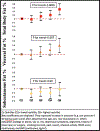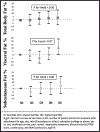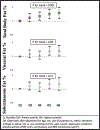Association of Visceral Adiposity With Pain but Not Structural Osteoarthritis
- PMID: 32039565
- PMCID: PMC7329601
- DOI: 10.1002/art.41222
Association of Visceral Adiposity With Pain but Not Structural Osteoarthritis
Erratum in
-
Error in Units of Measure on Figures in the Article by Li et al (Arthritis Rheumatol, July 2020).Arthritis Rheumatol. 2020 Dec;72(12):2135. doi: 10.1002/art.41606. Arthritis Rheumatol. 2020. PMID: 33459526 No abstract available.
Abstract
Objective: Osteoarthritis (OA) and pain are both made more severe by low-grade inflammation. This study was undertaken to examine whether visceral fat, a major source of inflammatory cytokines and adipokines, is associated with an increased risk of knee OA or musculoskeletal pain.
Methods: Subjects in the Multicenter Osteoarthritis Study cohort, who were age 50-79 years and had or were at high risk of knee OA, underwent whole-body dual x-ray absorptiometry (DXA) at baseline. At baseline, 30 months, and 60 months radiographs and magnetic resonance images (MRIs) of the knees were obtained, and patients were asked to score the severity of their knee pain and to identify sites of joint pain using a body homunculus. Baseline DXA scans were used to measure total body fat and visceral and subcutaneous fat in the torso. The association of fat depot size with structural outcomes (incident radiographic OA and cartilage loss and synovitis on MRI) and with pain outcomes (worsening knee pain, number of painful joints, and widespread pain) was assessed. Regression analyses were adjusted for age, sex, race, education level, smoking status, physical activity, body mass index (BMI), and depressive symptoms.
Results: Of the 2,961 participants at baseline, 60.7% were women. The mean age was 62.5 years and mean BMI was 30.5 kg/m2 . After adjustment for covariates, no fat measures were associated with any structural outcomes. However, total and visceral, but not subcutaneous, fat were positively associated with worsening knee pain (P = 0.0005 for total fat and P = 0.007 for visceral fat) and widespread pain (P = 0.001 for total fat and P = 0.02 for visceral fat), and the amount of visceral fat was associated with the number of painful joints (P = 0.07).
Conclusion: Our findings indicate that visceral fat is associated with an increased risk of musculoskeletal and widespread pain.
© 2020, American College of Rheumatology.
Figures
References
-
- Berenbaum F. Osteoarthritis as an inflammatory disease (osteoarthritis is not osteoarthrosis!). Osteoarthritis Cartilage. 2013;21(1):16–21. - PubMed





